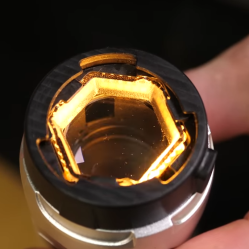“Look with your eyes, not your hands” is something many of us have heard while growing up, but that doesn’t apply to the touch-sensitive microscope [Steve Mould] got to play with.

The wand-like device is made by Gelsight, and instead of an optical lens like a normal microscope, it sports a gel pad on the sensing end. By squashing an object into the gel, the device is able to carefully illuminate and image the impression created. By taking multiple images lit from different angles, a lot of information can be extracted.
The result is a high-resolution magnification — albeit a monochromatic one — that conveys depth extremely well. It’s pretty neat clearly seeing tiny specks of dust or lint present on surfaces when [Steve] demonstrates imaging things like coin cells.
Many a hacker knows that the devil is in the details when it comes to executing an idea. Even so, the basic principles of the Gelsight seem simple enough and possibly within the realm of inspired DIY in the same way that we saw a CNC gantry and USB microscope repurposed as an optical comparator.
Watch the Gelsight in action in the video below, embedded below the page break.















not sure if publishing a partial fingerprint is a good idea in this modern world…
That being said, looks like it could be used as an extremely accurate fingerprint reader.
@Piecutter said: “That being said, looks like it could be used as an extremely accurate fingerprint reader.”
…looks like it could be used as an extremely accurate fingerprint DUPLICATOR.
No, it still only reads. Didn’t watch the video, but I’m sure the device doesn’t slide a finger out it’s backside with said finger print attached. Your comment comes across as either shady or paranoid.
The real problem is not accidentally publishing your partial fingerprint. It’s using fingerprint as an authentication method. Exactly because you leave the copies everywhere.
Very interesting, I can see many uses for this, the gel is the main factor in getting the detail and must have taken some time to develop.
I find it interesting that the gel doesn’t smooth out contours. It must be incredibly thin and tear resistant, else be very good at linearly transmitting force in one direction, like a pin board. It’s an interesting sort of device, in theory, there’s not much to it, but I’d hazard a guess, it’s probably a little over my budget.
It can be done with silver powder on 3m VHB tape. See the paper here – https://people.csail.mit.edu/kimo/publications/microgeometry/microgeometry.pdf
That is a great paper. Thanks
A very low Shore silicone with a layer of opaque silicone based paint should be fairly easy to replicate, getting it glass clear might be tricky.
Having used a lot of precision microscopes, the largest benefit to this concept would be the ability to always perfectly focus and white balance the image, since the background/lighting conditions never change. This is actually a great idea, given that accuracy of the object is maintained.
I can also see this being useful for imaging optically transparent objects, we have issues with that at my work in metrology.
I think that’s quite high on their use case. Hopefully your lab can get their hands on a practical model soon for the sake of your sanity, haha. Been dealing with white paint on white primer all day so I can understand a bit of the frustration of low contrast media
Imagine having two of these, the size of a table top, you place an object on one of them and put the other on top. Perhaps a fold down lid like a flat bed scanner. It makes a top and bottom mesh and stitches them together. You can then send it to a 3d printer and get a copy of it.
Facebook Research designed a simplified version of this and open sourced it: https://digit.ml/
Their paper also includes details of how they made their gel pad (use an airbrush to apply a thin layer of white silicone to a mold, then add a base layer of Smooth-On Solaris, finally glue the cured pad to an acrylic window with Smooth-On Sil-Poxy.)
Gelsight also sells a version of the Digit and replacement pads themselves.
The ultra-soft elastomer can also be a transparent cosmetic pad (silicon sponge, silisponge, etc…). A simple smartphone provides a perfectly adapted camera. All that is left to do is to design a small 3D printed box to install the LEDs, or perhaps, even simpler, to capture the light from the flashlight, using the transparent elastomer as a light guide. A nice DIY project!
@Marc PELTIER
And then there is getting the software…
Unless you only care for the ‘preview’ view of course.
Couldn’t all depth information be collected simply based on the depth to which the object is pressed into the gel as it’s being imaged?